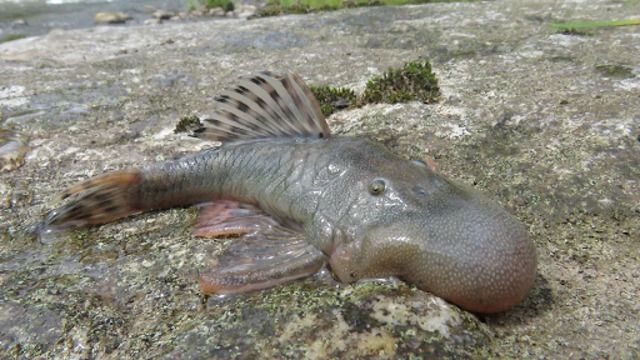
Scientists have discovered a unique fish with an enlarged head, known as a "blob-headed" fish. This species is a type of bristlemouth armoured catfish, marked by its unusual appearance that caught the attention of researchers during the expedition. BBC
In an exciting new discovery in the Alto Mayo region of Peru, scientists have uncovered 27 previously unknown species. This includes a fascinating amphibious mouse with webbed feet and a peculiar "blob-headed" fish. The findings were part of an expedition led by Conservation International, alongside local indigenous groups who contributed their valuable knowledge.
Alto Mayo, which includes parts of the Amazon rainforest, is a protected area in northern Peru, boasting diverse ecosystems and indigenous territories. Despite the area's natural beauty, it faces environmental pressures such as deforestation and agricultural expansion due to its relatively high population density. The expedition’s findings highlight the importance of preserving such ecosystems amidst these growing challenges.
Scientists have discovered a unique mouse species with webbed feet that is capable of living both on land and in water. BBC
"Discovering so many new species of mammals and vertebrates is really incredible, especially in such a human-influenced landscape," said Trond Larsen, senior director at Conservation International. This reflects how even in areas facing human impact, nature continues to surprise with its resilience and hidden treasures.
Researchers have identified a new species of dwarf squirrel, which will be classified under a new genus, making it a more distinct species. BBC
The discovery also has significant cultural importance. Yulisa Tuwi, an Awajún woman who assisted in the research, shared that the findings "allow the Awajún to protect our culture, natural resources, and our territory." The expedition has provided them with a deeper understanding of their land and its ecosystems. Indigenous groups like the Awajún hold extensive traditional knowledge of their environment, a crucial aspect in understanding and conserving these species.
Spiny mice are recognized for their unique spines, resembling hedgehogs. BBC
Among the exciting finds were a new species of dwarf squirrel, a variety of fish, amphibians, and butterflies. One of the most surprising discoveries was a "blob-headed" fish, a type of bristlemouth armoured catfish, which has an enlarged head—a feature never before seen by scientists. Interestingly, the indigenous Awajún people were already familiar with the species, proving how their deep connection with the land and its creatures contributes to modern scientific understanding.
This newly discovered species of climbing salamander was found in large numbers, but only in a small area of rare white sand. BBC
The dwarf squirrel discovered measures just 14cm, half the size of an average grey squirrel, making it one of the smallest known species. "It fits so easily in the palm of your hand. Adorable and beautiful chestnut-brown colour, very fast," said Larsen. The tiny squirrel is known for its quick jumps and ability to hide swiftly in trees, demonstrating the remarkable agility of these small creatures.
A small tree-dwelling opossum species has big ears that help it hear well. This marsupial, like others, carries its babies in a pouch. BBC
Another significant find was a new species of spiny mouse, distinguished by its stiff guard hairs, similar to a hedgehog's spines. In addition, the amphibious mouse, part of a rare group of semi-aquatic rodents, was discovered. These mice, with partially webbed feet, hunt aquatic insects and are considered among the rarest species, with few recorded sightings in the past.
A new type of skipper butterfly is among the 10 new butterfly species found during the expedition. BBC
This expedition not only adds valuable new species to the scientific community's understanding of Peru’s biodiversity but also showcases the importance of combining modern science with traditional ecological knowledge. It serves as a reminder of the need to protect these ecosystems, as they continue to hide countless species yet to be discovered.















